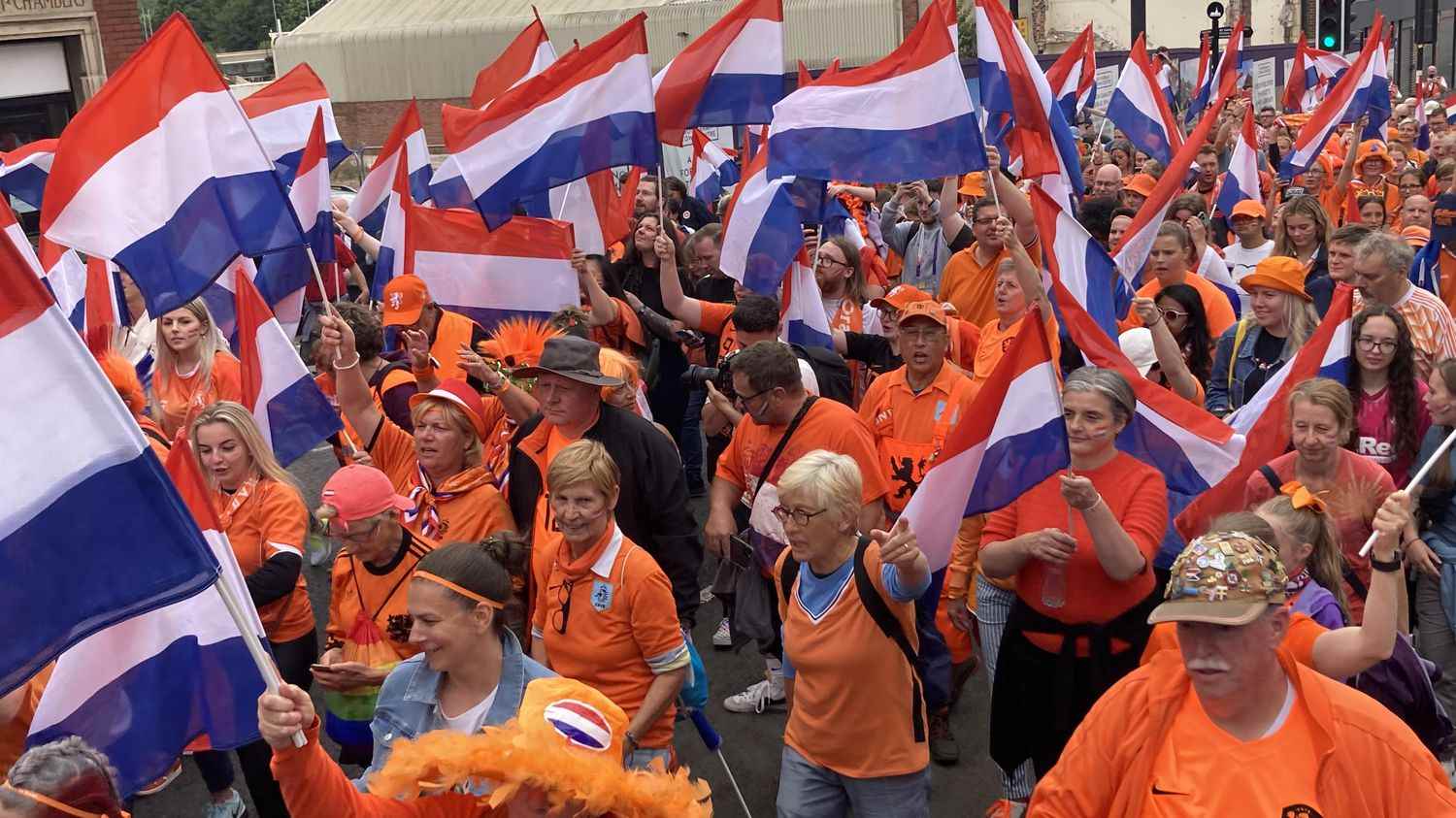The spinning in the footsteps of the “best audience in the world” of women’s football begins at the airport. Hardly arrived in Manchester that two orange bucket hats exceed the customs queue. A flashy orange jersey on the shoulders, matching flip-flops and neckband in the colors of the Netherlands, the Dutch do not go unnoticed at this Euro 2022. Opposed to France in the quarter-finals in Rotherham, on July 23, 2022, the orange wave swept through England.
And the least we can say is that the match in the stands will not take place. 6,000 Dutch supporters are expected tonight against barely 400 French. The 2017 European title at home for the Dutch was a spark and launched a popular craze for the women’s national team. We tried to unlock their secrets.
After staring at each other, the Dutch family lets out a big smile in the airport hall at the sight of tricolor supporters. On the pitch, the two countries may be adversaries, but until then, the Dutch are determined to celebrate with any willing soul. Barely time to pick up a “cab”, these little British taxis, that we have already lost sight of them. “Since this morning, I’ve only been going back and forth to Sheffield”, cautiously advances the taxi driver. Neither one nor two, we jump in to follow the trail of these self-proclaimed “best supporters in the world”, announced in number for the evening quarter-final.

The sequel takes place 1h30 away, in the English countryside. But in the Peak District National Park, no orange spot is on the horizon. We can just make out a few solitary sheep. And then we see them. Six orange spots in the distance. At their height, the taxi brakes and lowers the window. False alarm: “We are orange because we are doing work. But since this morning we have been regularly honked by cars who take us for supporters”. The crackling orange put us on the wrong track. You have to continue to the town of Rotherham, after an express passage by the hotel: “We are overbooked. Since this morning, it has been going by. It is good economically for Rotherham and all these small towns of barely 250,000 souls which host the matches”. But without any proof, we begin to doubt this breaking wave.
But when it comes time to get off the tram, everything becomes clear. The entire town is overrun with orange elves, who have been camping in the village since early morning. A flashy orange declined in paraphernalia of all kinds: bucket hat, cap, sweatshirt, three-piece suit and even hat in the shape of a forming wheel. No doubt, we found them. The fan zone took on the air of a Batavian national holiday. Difficult to detect tricolor jerseys in this scrum. The street vendors distribute their scarves with all their might : “Not a lot for France, a lot for the Netherlands”, compares Mary from her stand in the square.
Prominently parked is an orange double-decker bus. The aperitif is served there. Orange too, of course. “We do all the matches with the bus“explains Henk Van Beek, a tall Dutchman with a prominent beard and a broad smile. With 20 years of experience supporting the women’s team, Henk has also been following them physically since 2014: “We do absolutely all the national team matches. We don’t focus on the fact that it’s women’s football, or on the title of best supporters. Above all, we do what we like in this great atmosphere.“.

But Euro 2017 irremediably marked a turning point in the national team’s enthusiasm. “Winning after this course, for us, it created something very strong. Suddenly people began to vibrate and follow the women’s national team. It was also accompanied by a better valuation for the players, professionalism and therefore supporters “adds the Dutchman. And the craze takes from a very young age. Leenard Verke came with his two little girls, Isa and Lova, 8 and 7, from Rotterdam. “They are the ones who wanted to come. Until now, I had only followed the matches of the men’s national team or the girls’ but in clubs, not of the national team. But the youngest is all the way so we has come”.
A little away, we finally find some French. Lola Melkonian, Jenny Yriarte and Mélanie Touzet play at the same club in Paris. For months they have bet on the presence of the Blue quarter to take their tickets. “It gives us great pleasure to be together here! We put our Friday to be able to come this weekend to the quarter-finals. But it’s true that there are not many French people. It’s a shame that the craze of 2019 did not hold”, exposes Lola Melkonian. Jenny has been following the France team since the 2011 World Cup: “Of course there has been a development of the France team, that has nothing to do. They are better known individually and more publicized. But we are not yet up to the level of the Netherlands in terms of means.

Chantal Dejou, a former amateur player in the 1970s, also observes these developments from the United States where she lives: “We are not very numerous but the atmosphere is great! We will stay for the quarters, the halves and the final! We hope to see them go far. At least we party together, French and Dutch”.
From the best audience in the world to the audience of everyone, there was only one step. Still, on the ground, the French can climb to the semi-finals for the first time in their history at the Euro. Their European epic could, as for the Dutch, carry with it a momentum for the development of women’s football.
